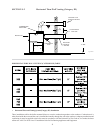• Vertical Direct Vent System Installation
These installations utilize the boiler mounted blower to draw combustion air from outdoors and uses the natural buoyancy
of the heated flue products to create a thermal driving head that expels the exhaust gases from the flue. The negative draft
must be within the range of- 0.01 to- 0.10” negative W.C. as measured 12 inches from the appliance outlet to insure proper
operation. The vent material must be in accordance with the above instructions for vent materials. Vent material must be listed
by a nationally recognized test agency.
The maximum and minimum venting length for Category I appliance shall be determined per the latest edition of the National
Fuel Gas Code (U.S.) and CAN/CGA-B149.1 and .2 Installation Code (Canada).
The connection from the appliance exhaust vent to the stack must be as direct as possible and should be the same as or larger
than the vent outlet. The vent must be installed to prevent accumulation of condensate and, where necessary, have means
provided for drainage of condensate. The horizontal breaching of a vent must have an upward slope of not less than 1/4 inch
per linear foot from the boiler to the vent terminal. The horizontal portions of the vent shall also be supported for the design
and weight of the material employed to maintain clearances and to prevent physical damage or separation of joints.
It is recommended that in colder climates, the intake vent be insulated.
• Vertical Direct Vent Termination
The exhaust vent terminal should be vertical and should terminate outside the building at least two (2) feet above the highest
point of the roof within 10 feet. The vent cap should have a minimum clearance of four (4) feet horizontally from and in no case
above or below (unless a four (4) foot horizontal distance is maintained) electric meters, gas meters, regulators and relief
equipment. The distance of the vent terminal from adjacent public walkways, adjacent buildings, open windows and building
openings must be consistent with the National Fuel Gas Code, or in Canada, the latest edition of CAN/CGA-B149.1 and .2.
Installation Code for Gas Burning Appliances and Equipment. Gas vents supported only by flashing and extended above the
roof more than five feet should be securely guyed or braced to withstand snow and wind loads.
The vertical direct vent cap is designed for roof top mounting only. The air inlet opening MUST be installed one (1) foot
above the roof line or above normal snow levels that might obstruct combustion air flow. This dimension is critical to the
correct operation of the boiler and venting system and reduces the chance of blockage from snow. The vent cap must have
a minimum 3 foot clearance from the air inlet opening.
37


















